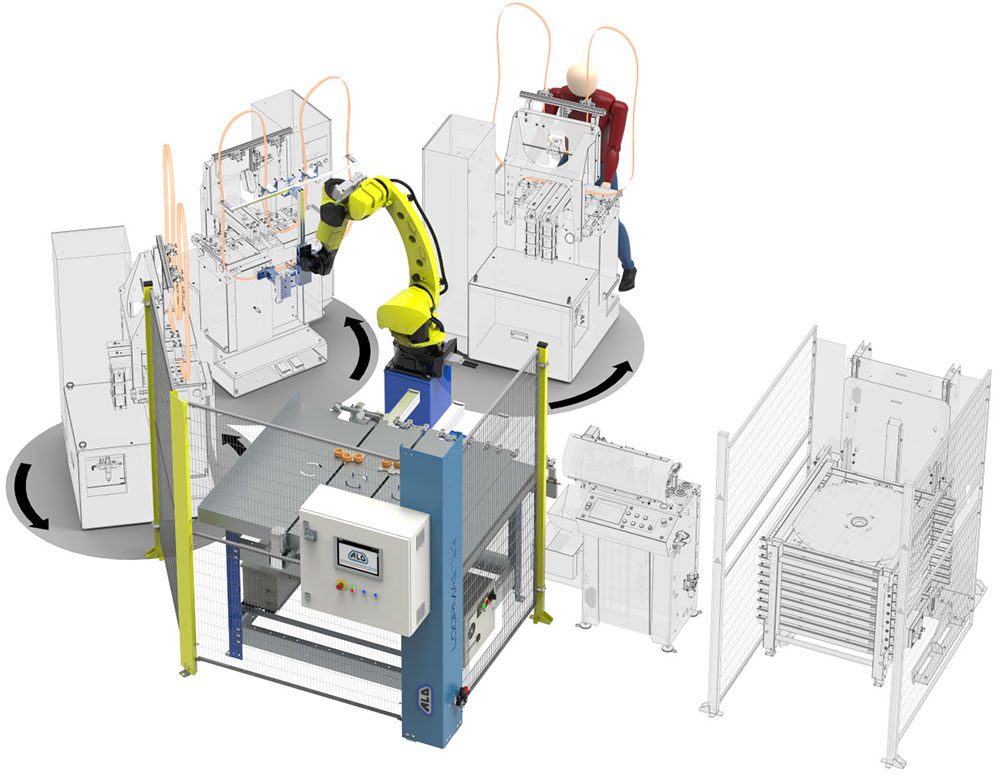Let us present the latest updates to our Loopmaster system – Turning Table and Dual Robots.
Turning table: Having Loopmaster welding unit(s) mounted on our swivel base that can be rotated 180 degrees to temporarily shut down the welding unit(s) offers several advantages, mainly related to safety, preventive maintenance and operational flexibility.
Here are the main benefits:
- Safety: The main reason for this setting is safety. By temporarily shutting down the welding unit, you can ensure that maintenance, adjustments or other tasks that require personnel to be in close proximity to the unit can be performed without endangering workers. This is especially important in environments where robotic equipment can pose a safety risk.
- Preventive Maintenance: Scheduled preventive maintenance is critical to the longevity and efficiency of production equipment. In the Loopmaster, the welding units will be the bottleneck that requires the most attention and maintenance. Being able to temporarily disable them in the Loopmaster cell allows for regular maintenance without disrupting the entire production process. This can help identify and fix potential problems before they lead to unexpected downtime.
- Changeover Flexibility: Changeover operations, which may involve switching to a band dimension or adjusting production parameters, can be completed more efficiently with this setup. The ability to temporarily shut down a welding unit and disconnect it from the Loopmaster cell reduces downtime during changeovers.
- Continuity of Operation: Even if one or two welding units are temporarily out of operation, the Loopmaster can continue to produce at reduced speed. This ensures operational continuity even during maintenance, adjustments or changeovers.
- Manual Operation: The ability to manually operate the welding unit outside the Loopmaster is advantageous for efficient processing of odd, urgent or one-piece orders.
- Efficient Resource Allocation: By switching between two welding units, you can optimize resource allocation and still maintain relatively high production rates in your Loopmaster cell. This flexibility enables efficient resource management and production planning.
- Reduced Downtime: The ability to disable a unit without affecting the entire cell’s production to a complete stop means you minimize downtime. This can lead to higher overall equipment effectiveness (OEE) and improved production efficiency.
- Adaptability: The system is adaptable to changing production requirements. When the volume of standard production is low, resources can be allocated to other tasks, such as maintenance or handling non-standard orders. This adaptability is valuable in dynamic manufacturing environments.
In summary, the Loopmaster with swivel-mounted welding units provides benefits in terms of safety, preventive maintenance, efficient changeovers, operational continuity and adaptability to varying production requirements. By switching between welding units, you can strike a balance between maintaining a high production rate and ensuring that necessary maintenance and adjustments to the welding units are carried out without causing significant disruption.
Dual Robots: We now have a concept for two robots where we have found the highest possible production by using only two welding machines.
| 1 robot, 1 welding machine | ||
| Welding time | Cycle time | Output/hour |
| 40 s | 85 s | 42/h |
| 60 s | 105 s | 34/h |
| 1 robot, 2 welding machines | ||
| Welding time | Cycle time | Output/hour |
| 40 s | 45 s | 80/h |
| 60 s | 53 s | 68/h |
| 2 robots, 1 welding machine | ||
| Welding time | Cycle time | Output/hour |
| 40 s | 60 s | 60/h |
| 60 s | 80 s | 45/h |
| 2 robots, 2 welding machines | ||
| Welding time | Cycle time | Output/hour |
| 40 s | 38 s | 94/h |
| 60 s | 40 s | 90/h |
| 1 robot, 3 welding machines | ||
| Welding time | Cycle time | Output/hour |
| 40 s | 45 s | 80/h |
| 60 s | 45 s | 80/h |
We are happy to hear your thoughts on the loopmaster project, please let us know!
